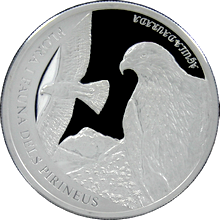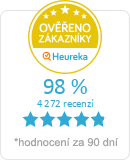Silver Coin Golden Eagle 2011 Proof Andorra
The product cannot be ordered now.
NOT IN STOCK
Detailed description
RAZITKO_POSTOVNE_ZDARMA_NENI
Flora and Fauna of the Pyrenees series
This exclusive silver coin issued by Andorra in 2011 from the Flora and Fauna of the Pyrenees series features a golden eagle on its reverse along with the inscriptions "FLORA I FAUNA DELS PIRINEUS" and "AGUILA DAURADA". The obverse shows the national emblem of Andorra with the inscriptions 'PRINCIPAT D'ANDORRA', the denomination and the year of issue.
The coin comes in a blue gift box with grey and silver trim, along with a numbered certificate of authenticity in a limited edition of only 3000 pieces for the whole world!

Golden Eagle

The golden eagle (Aquila chrysaetos) is one of the largest terrestrial eagles in the northern hemisphere and, after the sea eagle, the largest bird of prey living in the Czech Republic. It has a large range - it inhabits North America, Europe, Asia and North Africa.
The golden eagle is a robust bird with a long tail, large and strong talons, a strong beak and wide wings that have gaps between the talons to achieve higher lift when hovering. Coloration and size vary visibly by several subspecies (see below). Like many other raptors, female golden eagles are significantly larger than males. Plumage colouration ranges from blackish brown to dark brown with a golden tinge on the top of the head and nape of the neck, giving it its English name, Golden Eagle. The back is also usually lighter than the belly. The sexes do not differ from each other in colouration. Young birds have light feathers on the wings and at the base of the tail, which disappear in the fifth year of life.
In search of food, the golden eagle soars at high altitude and scans the terrain below it. It has very good eyesight and can spot its prey from a great distance. When it does, it slowly swoops down and grabs its unsuspecting prey in its powerful talons and usually carries it to high ground. With its powerful beak, it then dismembers and tears it into smaller pieces, which it consumes. Very often it hunts in pairs, taking advantage of mutual cooperation. Its food is most often marmots, hares, mice, weasels, foxes, young deer and occasionally small to medium-sized birds. During winter, when food is scarce, it often feeds on carrion.
Product Specifications
Application form
Thanks to our position on the market, we can try to provide you with a product that is currently sold out or unavailable for a longer period of time. Simply fill in the application form and we will contact you as soon as we are able to secure the product.
Filling in the application form is not binding for you.
Buyback contact form
We will be happy to buy investment metals purchased from us or from our competitors. Our customers always get the highest price offered at any given time. Fill out the form below and we will contact you. Thank you for your trust.




